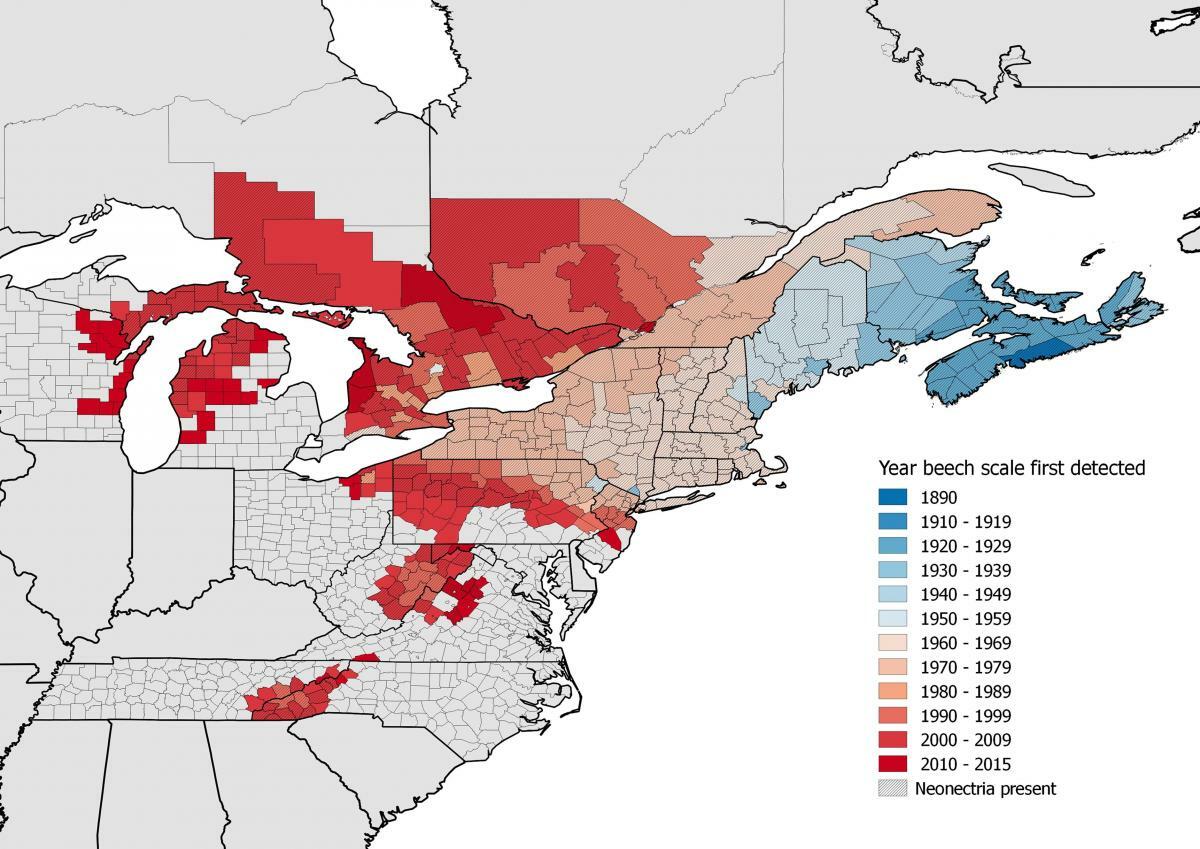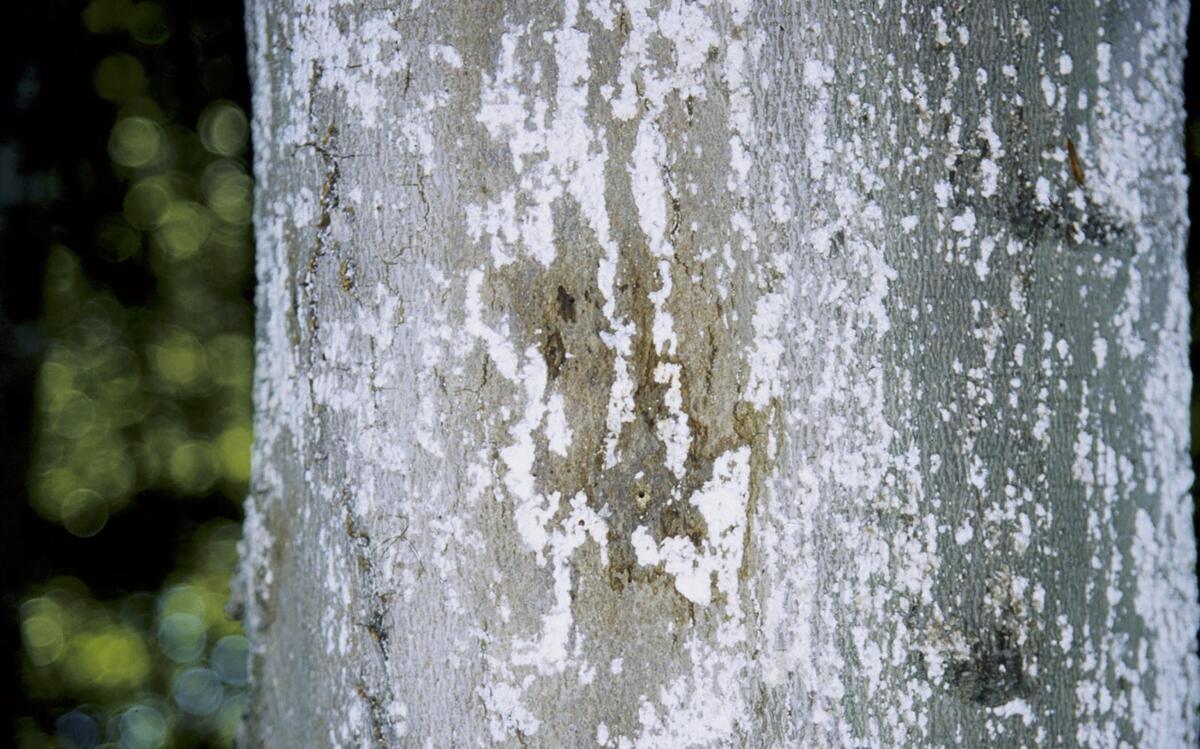
Global S&T Development Trend Analysis Platform of Resources and Environment
| Beech Bark Disease | |
| admin | |
| 2022-07-01 | |
| 发布年 | 2022 |
| 语种 | 英语 |
| 国家 | 美国 |
| 领域 | 资源环境 |
| 正文(英文) |
It must have seemed like a good idea at the time. When the gardeners of the Public Gardens of Halifax, Nova Scotia planted a European beech tree around 1890, they knew it was a beautiful and long-lived tree that would grace the Public Gardens for decades. What they didn’t know is that tiny insects hiding on that tree would spread to the native beech trees nearby and start the epidemic of beech bark disease in North America. Beech bark disease has been spreading through the American beech (Fagus grandifolia) population ever since, killing countless trees and altering the structure and food webs of forests from Canada’s Maritime Provinces to North Carolina. What is beech bark disease and where does it occur?Beech bark disease is a ‘disease complex’ that consists of an imported insect (the beech scale, Cryptococcus fagisuga) and two species of bark-cankering fungi (Neonectria faginata and N. ditissima). A native insect (the birch margarodid, Xylococculus betulae) appears to also be involved in some areas, but beech bark disease was unknown in North America until the invasion of the beech scale1. The exact nature of the interactions between these organisms is an area of active research, but it is clear that the beech scale insect punctures the bark of the tree with its feeding tube, allowing the fungi to enter. The fungi cause bark lesions that grow and eventually girdle the tree, disrupting its internal nutrient transport system and causing it to deteriorate slowly. The decline can take years to decades, but is usually fatal. The disease also makes the trees more vulnerable to infection by wood-rotting fungi and damage by wind and ice.  The beech scale insect, which is native to Europe, is small (0.5-1 mm, or 0.02-0.04 inches) and feeds on tissues just under the bark. When it settles on a tree to feed, it covers itself in a white waxy substance that is easily visible on heavily infested trees. Only female beech scale insects have been observed in North America, indicating that the insects reproduce asexually. An early larval stage of the insect can crawl about, and may be dispersed by hitching a ride on birds or other animals. The insects can also be spread by people moving infested live plants or bark-clad beech logs such as firewood. Since the initial establishment of beech bark disease in Nova Scotia, the disease has advanced as far south as the Great Smoky Mountains of Tennessee/North Carolina and as far west as Wisconsin. While it has not yet reached the entire range of beech, the disease has existed for decades in the region where the trees are most abundant, including New York, New England, and southeastern Canada. What are the impacts of beech bark disease?Beech is one of the most abundant and dominant trees in the upland forests of northeastern North America. In the dim forest understory, the smooth, silver-gray bark of a mature beech tree stands out. Unfortunately, this sight is increasingly rare. Beech bark disease attacks the largest trees first, making trees with a diameter of over 50 cm (20 inches) hard to find. When the disease causes bark cankers, beech’s distinctive gray bark is disfigured and hardly recognizable. The decline of canopy beech trees is often accompanied by growth of dense thickets of beech saplings, which will eventually get the disease as they grow older. As a result, in many places the disease has transformed beech from a dominant tree in the forest canopy to a small understory tree. In forests where beech and sugar maple compete, sugar maple can take over the gaps in the canopy left by dying beech, thus transforming the dominant tree species in the forest. Such shifts have important effects on soil development and nutrient cycling2.  In the beech-maple-birch forests that dominate northern New York and New England, beech is the only species that produces “hard mast”-- large seeds that serve as important food for wildlife. Turkeys, blue jays, squirrels, deer, bears, and many other animals rely on beech seeds in these forests1. In the fall, bears climb and shake beech trees to produce a rain of beech nuts, which the bears then eat from the ground. This helps the bears fatten up for the winter hibernation. The loss of beech trees, especially the largest ones, reduces the beech nut crop and forces bears and other animals to find other foods. Despite its important ecological role, beech is not a particularly valuable timber tree in North America. In fact, many loggers consider it a nuisance because its abundant saplings impede the movement of equipment through the forest. As a result, research on how to maintain healthy beech forests is lacking. Evidence of disease resistanceThere is a low level of natural resistance to beech bark disease in the American beech population. Our research in the Catskill Mountains of southeastern New York showed that ~99% of beech trees had some sign of beech bark disease, but 10-20% appeared to still be in good condition, indicating some tolerance of the disease3. While large beech trees are rare, they do exist. Healthy beech can still be found in disjunct populations, including lowland and coastal plain forests along the US East Coast. It is not known whether these trees have been spared because of some genetic resistance or because they are far from areas where the disease is most prevalent. The physiological nature of beech bark disease resistance is not completely understood, but it may be affected by the level of nitrogen in the tree1. Like many plant-eating insects, the beech scale’s population growth is limited by the amount of nitrogen it can obtain from its food. In eastern North America, air pollution from fossil fuel combustion and agricultural activities has delivered excess nitrogen to forests for decades. This may make trees more susceptible to the disease4. Other threats to beech treesBeech bark disease is transforming beech forests in northeastern North America – and it’s not the only threat. Two new imported pests also attack beech trees. Beech leaf disease was discovered in 2014 near Cleveland, Ohio, and has since spread to New York and southern New England5. It appears to be caused by a foliar nematode, a microscopic worm-like creature. The disease first attacks foliage, eventually killing the entire tree. Another threat is the beech leaf-mining weevil, a foliage-eating beetle that was discovered in Nova Scotia in 2012. It is killing beech trees in forested and urban areas of that province, causing up to 70% mortality of beech in infested stands6. If either or both of these pests spread throughout the range of beech, which seems likely, their impacts in combination with beech bark disease leave the future of the beech tree in jeopardy.  What can be done about beech bark disease?For individual trees, either systemic or surface-applied insecticides can be used to control the beech scale insect. This is most useful in the initial period when the scale insect has attacked the tree but the fungi have not yet established. No biological control organisms (i.e., predators or parasites of the beech scale insect) are available for more widespread control of beech bark disease. It seems likely that the disease will spread throughout the entire range of American beech. Forest owners should check the progress of the disease on individual trees and retain trees that show some resistance; those trees represent the foundation of a resistant and healthy future beech population. Beech firewood and live trees should not be transported to new areas because beech bark disease can be spread by moving infected plant material. To prevent future ecological disasters like the beech bark disease, the US, and all countries, need to impose more stringent controls on the international movement of live plants. Cary Institute’s Tree-SMART Trade program seeks to develop and communicate more effective trade policies that will help prevent the importation of damaging forest pests and diseases.  References1 Cale, J. A., M. T. Garrison-Johnston, S. A. Teale, and J. D. Castello. 2017. Beech bark disease in North America: Over a century of research revisited. Forest Ecology and Management 394:86–103. Illustrations follow
|
| URL | 查看原文 |
| 来源平台 | Cary Institute of Ecosystem Studies |
| 文献类型 | 新闻 |
| 条目标识符 | http://119.78.100.173/C666/handle/2XK7JSWQ/352401 |
| 专题 | 资源环境科学 |
| 推荐引用方式 GB/T 7714 | admin. Beech Bark Disease. 2022. |
| 条目包含的文件 | 条目无相关文件。 | |||||
| 个性服务 |
| 推荐该条目 |
| 保存到收藏夹 |
| 查看访问统计 |
| 导出为Endnote文件 |
| 谷歌学术 |
| 谷歌学术中相似的文章 |
| [admin]的文章 |
| 百度学术 |
| 百度学术中相似的文章 |
| [admin]的文章 |
| 必应学术 |
| 必应学术中相似的文章 |
| [admin]的文章 |
| 相关权益政策 |
| 暂无数据 |
| 收藏/分享 |
除非特别说明,本系统中所有内容都受版权保护,并保留所有权利。
修改评论